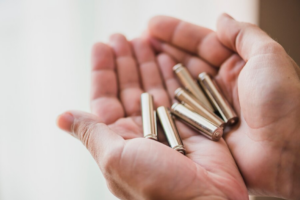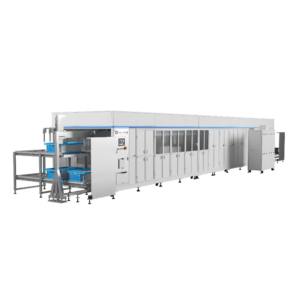Batteries, especially those placed in electric vehicles (EVs), renewable energy storage, and portable electronics, demand intricate and reliable assembly processes. EV battery components such as electrodes, separators, and current collectors must be accurately shaped and assembled to ensure optimal performance and safety. This is why laser manufacturing comes in. Laser manufacturing is a process that utilizes laser technology to perform various manufacturing operations. But how does it empower battery assembly in detail? To understand this technology comprehensively for battery assembly, please continue reading!

(Copyright Photo from: https://www.freepik.com/free-photo/safety-measures-stickers-assembly-lines-operated-by-heavy-machinery-render_147665123.htm#fromView=search&page=1&position=1&uuid=4abd6006-ee41-43c4-ba22-d17f578ab848)
Different Laser Technology Approaches are Used in Battery Manufacturing
The following are some laser technology approaches that are used in the battery assembly or manufacturing process. I used a laser beam to cut the different components of the battery precisely. The laser cut electrodes, separators, and casings with high precision and minimal material waste.
1. Fiber Lasers
Fiber lasers are widely used in battery manufacturing for various applications such as cleaning, texturing, welding, and marking battery components[1]. They offer a high level of precision and can be optimized to meet different production requirements.
2. Diode Lasers
Diode lasers are used for efficient drying processes in battery manufacturing. By projecting a high-intensity beam onto the electrode, the diode laser heats up the graphite particles, causing the liquid to evaporate[2]. This laser manufacturing method is energy-efficient and takes up less space compared to traditional gas-powered continuous furnaces.
3. Ultrashort Pulse Lasers (USP)
Ultrashort pulse lasers are utilized for modifying electrode structures in battery manufacturing. By introducing hole structures or channels into the battery electrode, the distance the ions have to travel is reduced, resulting in shorter charging times and increased battery lifetime[2]. The short interaction time of the laser pulses prevents the holes from melting, ensuring the battery does not lose power.
4. Near-IR Fiber Lasers
Near-IR fiber lasers are used for laser cutting of electrodes in battery manufacturing. This laser cutting offers advantages over traditional mechanical blanking methods, such as increased flexibility in electrode design and reduced tool wear. The thermal impact of laser cutting can be minimized by using shorter pulse widths in the femtosecond range.
Applications of Laser Manufacturing in Battery Assembly
1. Electrode Cutting and Shaping
Electrodes are an important component of barriers. Laser technologies can ensure that every electrode must have a precise shape for optimal function. Laser beam cuts these electrodes accurately so as to ensure optimal electrode performance and uniformity, which directly impacts the battery’s efficiency and lifespan.
2. Battery Components Welding
The battery has different components. When welding them, such as current collectors, tabs, and casings, the precision of laser manufacturing presents its power fully: it allows components to be assembled seamlessly and ensures robust and reliable connections. So it maintains electrical conductivity and mechanical integrity.
3. Surface Cleaning and Treatment
Laser surface treatment is necessary to move contaminants like oxides and residues from surfaces before battery assembly. It ensures optimal adhesion and electrical contact in subsequent processes. Plus, laser manufacturing can be used in making logos, patterns, two-dimensional codes, and so on. This capability enhances the functionality and traceability of battery products by allowing for the precise application of complex designs and information directly onto the battery surface.
Advantages of Laser Manufacturing in Battery Production
When talking about the benefits of laser technologies that are applied in battery manufacturing, you must grasp some general thoughts from the classification and application above. Specifically, here are 4 advantages of laser manufacturing during the battery manufacturing process:
- Provides the highest precision, which is not possible without a laser. Its results are consistent and ensure better performance of the battery
- Minimizes mechanical stress and contamination, preserving the integrity of delicate battery components
- Be versatile enough as it fits different needs of battery manufacturing or assembly processes
- Reduces material waste and increased production efficiency translate to lower overall manufacturing costs
Powerful Laser Manufacturing Machine Used in Battery Production: Laser Sealing Machine
Above all, laser manufacturing can empower battery assembly to achieve accurate, different, and unique demands for your clients. In the battery manufacturing process, battery sealing and welding are the significant phrases that influence the overall performance and longevity. Laser manufacturing can present its power perfectly in these stages, and our SZJ Automation’s Laser Sealing Machine is an excellent aid in this regard.

Our SZJ Automation’s Laser Sealing Machine is a state-of-the-art solution that optimizes battery assembly and manufacturing. This machine offers sealing between the top cover and the shell of a square aluminum shell battery. Sealing leveraged by advanced laser technology, this machine can deliver precise, reliable, and efficient sealing of battery components. Here are more details about this laser sealing machine:
- Welding Laser: Equipped with a powerful 2kw+2kw ring spot or compound welding system, our machine has superior welding capabilities that ensure solid and consistent seals on battery cells
- Equipment Capacity: Capable of handling 6 to 20 pieces per minute (PPM), our laser sealing machine is optimized for both small and medium-scale production needs, providing flexibility in manufacturing volumes
- Equipment Yield: Delivers a high production yield of ≥5%, ensuring that the vast majority of outputs meet quality standards, thereby reducing waste and increasing overall efficiency
- Equipment Failure Rate: Maintains a low failure rate of ≤2%, which minimizes downtime and maintenance requirements, keeping production lines running smoothly and efficiently
- Noise Level: Operates with a noise level of ≤75db, making it suitable for environments where noise control is crucial without compromising the working conditions of the facility
Conclusion
Laser manufacturing technology is a power tool in battery manufacturing assembly. It provides precision, speed, and efficiency from electrode cutting to surface treatment. You can’t deny the laser’s role in producing high-performance and reliable batteries. Our SZJ Automation’s Laser Sealing Machine is the best example of a laser’s potential to optimize battery manufacturing.

Except for this Laser Sealing Machine, we also have a wide range of equipment to facilitate the battery manufacturing process. And our newly built battery manufacturing equipment factory in Xiangyang, Hubei, China, spans an impressive 20,136.6 square meters. A standout feature of the facility is its large testing workshop, which occupies 12,463.83 square meters. This space is dedicated to ensuring that every piece of equipment produced meets stringent quality standards, significantly enhancing the reliability and competitiveness of our products in the market.
Above all, you can trust our delivery. If you are also into battery manufacturing and looking for battery manufacturing equipment suppliers, come to us, SZJ Automation!
Reference
[1]Available at: https://www.laserax.com/batteries
[2]Available at: https://www.fraunhofer.de/en/press/research-news/2023/april-2023/laser-technology-for-energy-efficient-production-of-battery-cells.html
[3]Available at: https://www.alliedscientificpro.com/blog/welcome-to-our-blogs-1/application-of-laser-technology-to-li-ion-battery-production-87



